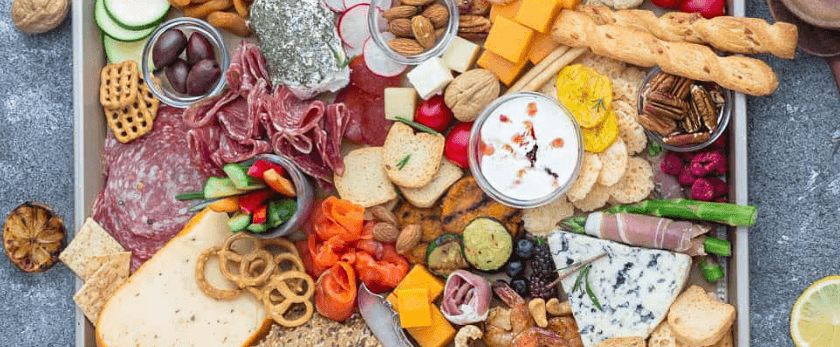In today's world, where environmental concerns are at an all-time high, it's important to make conscious choices that can help reduce our carbon footprint. One simple yet effective way to do so is by making our own homemade platters. Not only are they better for the environment, but they also add a personal touch to any gathering or event. In this article, we'll explore why store-bought platters are harmful to the environment, the benefits of making your own, and how to create your own eco-friendly platters.
The Environmental Impact of Store-Bought Platters
Store-bought platters may seem convenient, but they come with a hefty environmental cost. Here are some reasons why:
1. Single-Use Plastic Packaging
Most store-bought platters come in plastic packaging that is meant to be used once and then thrown away. This contributes to the growing problem of plastic pollution, as these packages often end up in landfills or our oceans, taking hundreds of years to decompose. In fact, according to a report by the World Economic Forum, there will be more plastic than fish in the ocean by 2050 if we continue with our current consumption and disposal habits.
2. Transportation Emissions
Store-bought platters are often transported long distances, resulting in high carbon emissions. This is because they are usually made in large factories and then shipped to various stores, increasing their carbon footprint. These emissions contribute to climate change, which has far-reaching consequences for our planet.
3. Unsustainable Ingredients
Many store-bought platters contain ingredients that are not sustainably sourced. This means that they are produced in a way that harms the environment, such as using pesticides or contributing to deforestation. By purchasing these platters, we are indirectly supporting unsustainable practices that have a negative impact on the planet.
The Benefits of Making Your Own Platters
Making your own platters may require a bit more effort, but the benefits for the environment are worth it. Here's why:
1. Reduces Plastic Waste
By making your own platters, you can avoid the single-use plastic packaging that comes with store-bought options. Instead, you can use reusable containers or wrap your platters in beeswax wraps, which are a more sustainable alternative to plastic wrap. This helps reduce the amount of plastic waste that ends up in landfills and our oceans.
2. Lowers Carbon Footprint
Making your own platters also reduces the carbon emissions associated with transportation. By using locally sourced ingredients and making the platters at home, you can significantly lower your carbon footprint. This is because the ingredients don't have to travel long distances, reducing the emissions from transportation.
3. Supports Sustainable Practices
When you make your own platters, you have control over the ingredients you use. This means you can choose to use sustainably sourced ingredients, such as organic produce or ethically raised meats. By supporting sustainable practices, you are contributing to a healthier planet and a more sustainable future.

How to Make Your Own Eco-Friendly Platters
Now that we've established the benefits of making your own platters, let's dive into how you can create your own eco-friendly platters. Here's what you'll need:
- Reusable containers or beeswax wraps
- Locally sourced ingredients
- A variety of fruits, vegetables, and other snacks
- A cutting board and knife
- Optional: decorative platter or serving tray
Follow these steps to create your own homemade platters:
1. Choose Your Ingredients
The first step is to decide what you want to include in your platter. You can choose a variety of fruits, vegetables, and other snacks, such as nuts, crackers, or dips. Try to use locally sourced ingredients to reduce your carbon footprint and support local farmers.
2. Prepare Your Ingredients
Wash and cut your fruits and vegetables into bite-sized pieces. You can also add some decorative touches, such as arranging the fruits and vegetables in a visually appealing way. If you're using dips, transfer them into small reusable containers.
3. Assemble Your Platter
Place your prepared ingredients on a decorative platter or serving tray. You can also use a cutting board or any other flat surface. Be creative and have fun with the presentation of your platter.
4. Wrap or Cover Your Platter
If you're using reusable containers, simply cover them with a lid. If you're using beeswax wraps, wrap the platter tightly to keep the ingredients fresh. You can also use a cloth or tea towel to cover the platter.
5. Transport and Serve
When transporting your platter, make sure it is secure and won't spill. Once you reach your destination, uncover the platter and serve. Your homemade eco-friendly platter is now ready to be enjoyed!
Conclusion
Making your own homemade platters is a simple yet effective way to reduce your environmental impact. By avoiding single-use plastic packaging, lowering carbon emissions, and supporting sustainable practices, you are taking a positive step towards a greener, more eco-friendly lifestyle. So next time you're planning a gathering or event, consider making your own platters and make a positive impact on the planet.









